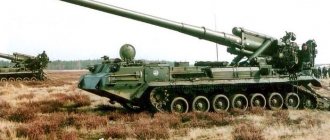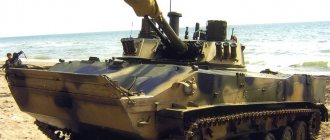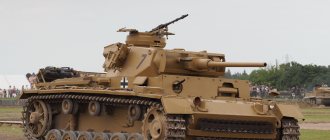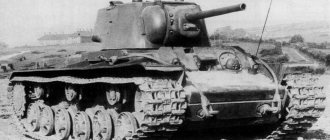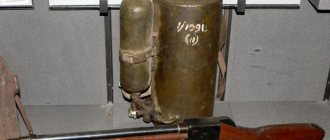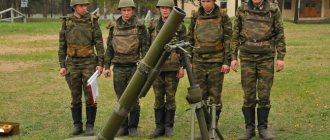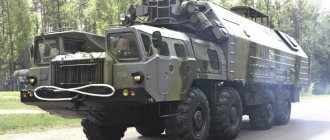During the First World War, the warring countries began to look for a new way to defeat the enemy. At the end of July 1915, British troops were attacked by a new weapon: flames burst out of the German trenches, burning everything in their path. Having given up their positions, the British infantry fled to the rear without wasting a single cartridge. On the Russian front, the Germans first used a flamethrower in 1916 in the battle near Baranovichi.
After this, the Russians began seriously studying the design of the flamethrower. Then a backpack flamethrower designed by Tovarnitsky was adopted. In the same year, engineers proposed the first high-explosive flamethrower: from it the combustible mixture was ejected using a powder charge, and not with compressed gas. In total, about 300 units were produced, but they were never used during the First World War. The first combat use was during the Civil War. In peacetime in the USSR, the development of flamethrowers was one of the main tasks. During this period, Soviet tanks were equipped with flamethrowers to increase military power.
In the First World War, two types of flamethrowers were used: backpack flamethrowers for the offensive, and heavy ones for the defense. Later, a high-explosive flamethrower was adopted for use. Let's look at each one separately.
Flamethrower designs
The backpack flamethrower is made of an oval steel container with a volume of 15-20 liters, inside of which there is a flammable cocktail and compressed gas. When the tap is opened, the liquid rushes out through a plastic rubber hose about 2 meters long and a metal tube and ignites with the help of an igniter. This design did not provide a shutdown lever in the event of death or injury of a soldier. The weight of the structure when fully filled reached 24 kilograms and was worn using two belts on the soldier’s back. The range of the jet decreased in accordance with the remaining gas in the cylinder and reached 15-30 meters in length. The jet operated continuously for 50-55 seconds.
The heavy flamethrower is made from a tank with a volume of up to 200 liters with an outlet pipe, an 8-meter long hose, a tap and special handles for carrying by hand. A fire hose with a control handle at the igniter mounted on a carriage. The weight reaches 160 kilograms, while the maintenance team includes 4 people, including a flamethrower. The range of the jet exceeds 50 meters in length and the affected area is about 400 square meters. One shot can hit up to an entire infantry company. It is also equipped with a sight for aiming at the target. But at the same time it was considered unsuitable for field defense, due to the complexity of installation, movement and the presence of a large supply of flammable cocktail. Time with continuous action is about 60 seconds, with breaks of up to 3 minutes.
Also used to stop tanks as it will catch fire in most cases.
The high-explosive flamethrower differs in design from its predecessors. The fire mixture is pushed out of the canister by pressure from the combustion of gunpowder. It consists of an oblong steel canister inside of which there is a fixed piston. An incendiary cartridge is installed on the nozzle, and a powder cartridge is installed in the charger. An electric igniter is mounted in it, the wires from which go to the explosive installation. Weight in running order is approximately 32 kilograms. The flamethrowing radius reaches 50 meters, the duration of action is 1-2 seconds.
All the power of flamethrowers is contained in a cocktail of flammable substances, the combustion temperature of which is from 10,000 to 35,000 degrees Celsius with an extremely stable flame. They are made from various flammable mixtures of petroleum products. Such mixtures are liquid (gasoline with heavy motor oils) and viscous (with the addition of polystyrene). The first ones flow perfectly into various cracks and holes without sticking to them. The second ones, also known as napalms, stick to the target and increase the affected area. Napalm easily sticks even to wet targets. There are also so-called pyrogens - napalm with the addition of powders of certain metals (magnesium, sodium) and heavy petroleum products (asphalt and fuel oil).
Three strict rules apply to flammable cocktails:
- the liquid must be of a larger mass removed (or sprayed at the outlet), which affects the flight range;
- should not burn too strongly in the air (so they burn in the air and do not reach the target);
- 100% combustion.
The flamethrower is the most versatile weapon.
Home » Alternative History - options for forks » Flamethrower as the most universal weapon.
Alternate History - options for forks
Sezh 11/23/2017 568
-1
in Favoritesin Favoritesfrom Favorites 0
The flamethrower is the most versatile weapon.
In one article by colleagues Ansar,
****When I started this material in 2015, I remembered which one, but now I don’t remember - so trust the author when you look at the text***
or rather, in the comments, it is mentioned that the mortar is the most versatile weapon.
And what?
In addition to the traditional shooting at infantry both in the field and behind the hill, you can do many more things. You can shoot from the shore at ships, and from ships the same (monitors, gunboats, boats), at tanks and from tanks (more precisely, a self-propelled mortar on a tank chassis). It is also possible by aviation, and not only when it is on the ground, but also in the air.
In general, an anti-personnel, anti-tank, anti-aircraft gun, it would seem - much more versatile?
But no, it can be even more universal!
And from infantry, and from tanks, and from aviation, and from ships, and from airplanes, and submarines.....
And the list doesn't end there!
FLAMETHROWER, a weapon designed to destroy enemy personnel located openly in field structures, armored vehicles, buildings and other shelters with a burning fire mixture; setting fire to tanks, vehicles and supplies, as well as creating fires in populated areas and forests.
Flamethrowers are used to support infantry and motorized rifle units on the offensive and to strengthen them in defense. A flamethrower consists of one or more reservoirs (cylinders) for a fire mixture, a cylinder with compressed gas (air, nitrogen) or powder charges to create pressure, a fire hose and a device (pyrotechnic cartridge) for igniting the jet. Flamethrowers are divided into backpack, heavy, mechanized and tank.
The effectiveness of flamethrowers depends on meteorological conditions: strong humidity (rain, snow) significantly weakens the effect of the burning jet.
Regardless of the type and design, the principle of operation of flamethrowers is the same. Flamethrowers are devices that emit jets of highly flammable liquid over a distance of 15 to 200 m. The liquid is ejected from the reservoir through a special fire nozzle using the force of compressed air, nitrogen, carbon dioxide, hydrogen or powder gases and is ignited when leaving the fire nozzle with a special igniter.
In World War I, two types of flamethrowers were used: backpack flamethrowers for offensive operations, heavy ones for defense. Between the world wars, a third type of flamethrower appeared - high-explosive.
A backpack flamethrower is a steel tank with a capacity of 10–25 liters, filled with flammable liquid and compressed gas. When the tap is opened, the liquid is thrown out through a flexible rubber hose and a metal fire nozzle and ignited by an igniter.
The heavy flamethrower consists of an iron tank with a capacity of about 200 liters with an outlet pipe, a tap and brackets for manual carrying. A fire hose with a control handle and an igniter is movably mounted on a carriage. The flight range of the jet is 40–60 m. A shot from a flamethrower hits an area of 300–500 m2. One shot can knock out up to a platoon of infantry.
A high-explosive flamethrower differs in design and principle of operation from backpack flamethrowers - the fire mixture is ejected from the tank by the pressure of gases formed during the combustion of a powder charge. An incendiary cartridge is placed on the nozzle, and a powder ejection cartridge with an electric fuse is inserted into the charger. Powder gases eject liquid at a distance of 35–50 m.
The main disadvantage of the jet flamethrower is its short range. When shooting at long distances, the system pressure needs to increase, but this is not easy to do - the fire mixture is simply sprayed (sprayed). This can only be combated by increasing the viscosity (thickening the mixture). But at the same time, a freely flying burning jet of fire mixture may not reach the target, completely burning out in the air.
So flamethrowers.
The most important advantage of a flamethrower is its ease of production. Unlike a grenade launcher/machine gun/machine gun, a flamethrower is made from available things - an aerosol can (ANY) and fire (a lighter), water guns charged with gasoline + a lighter.
Usage.
Armored vehicles.
In mechanized flamethrowers, the flamethrower device is mounted on a self-propelled chassis in a domed turret, and the incendiary mixture tanks are mounted in the vehicle body. The flamethrowing range is about 180 m, its duration reaches 40 seconds. Tank flamethrowers are the main or auxiliary weapons of a tank and are used both offensively and defensively.
Fleet.
Surface.
Flamethrowers were the main force of ships (besides rams and catapults) of both the Ancient World and the Middle Ages. It would seem that with the development of artillery they are a thing of the past, but this is not so
“Having gone out to search for him, the squadron did not spend too much time on it - the enemy was discovered already on the second day, in the evening. A warning shot against the wind did not lead to any result, the impudent one did not even react. Having set all sails, the British set off in pursuit. It continued with varying success, but it was not possible to get close to the shot. It was getting dark, and further pursuit became dangerous. It was easy to run into rocks - judging by the map, there were some here. The frigate commanders decided to drift.
Already in the morning, the watchmen heard some kind of knocking in the sea... completely unusual and incomprehensible. It seemed like there was a whiff of smoke... but where does the smoke come from in the sea? And even without fire?
However, the fire did not take long to appear!
Something splashed into the sea, and the darkness was cut through by a fiery stream that flew out from somewhere in the darkness. The lead ship burst into flames, as if a pile of straw had been dumped on its deck and a lit torch had been brought to it.
The ships' bells rang and the boatswain's pipes began to sound. But it was too late.
A vague knock, a hiss - and the same jet hit the side of the second frigate. People engulfed in fire rushed across the deck with screams.
A salvo thundered from the side of the third ship - the gunners discharged their guns at the sound. Whether they managed to hit anyone or not remains a mystery.
And in a matter of minutes the stern of the third and last frigate was already on fire. The command “Save yourself who can!” sounded too late... the cruise chamber exploded on the first ship" (Guard of the Fallen. Britain to the bottom! A. Kontorovich)
But flamethrowers have not left ships in our time. Continue to stand on gunboats and cutters
Submarine fleet.
If you think that a flamethrower is a weapon only for a surface ship, then you are mistaken. A flamethrower is an excellent means of self-defense for a submarine.
“In theory, the project was ideal. It was assumed that the Seeteufel would be capable of carrying out sabotage, both at sea and on land, while being deep behind enemy lines. The cigar-shaped amphibian could masquerade as a regular fuel tank. According to the developers, at night this “tank” could come to life, plunge into water and sneak up on its target completely unnoticed. In the water, the Monkfish attacked its opponents with torpedoes or mines; on land, it defended itself with a heavy machine gun or flamethrower.”
Defense/Fortifications.
The main stereotype is that flamethrowers are used only offensively. It is very effective to destroy all sorts of bunkers, shelters, and clear apartments of all kinds of parasites in the form of soldiers of the enemy army. But flamethrowers are also used in defense.
“Ahhhhhhhhhhhhhhhhhhhhhhhhhhhhhhhhhhhhhhhhhhhhhhhhhhhhhhhhhhhhhhhhhhhhhhhhhhhhhhhhhhhhhhhhhhhhhhhhhhhhhhhhhhhhhhhhhhhhhhhhhhhhhhhhhhhhhhhhhhhhhhhhhhhhhhhhhhhhhhhhhhhhhhhhhhh-of-screaming Japanese man, who had impaled himself in a jump on the integral bayonet of a three-ruler.
The screech instantly drowned out the roar of explosions. The infantrymen did not spare 'hand artillery', generously throwing 'beaters' on long wooden handles and cast iron 'pineapples'.
The Japanese who had almost reached the line of trenches, lunettes and forts were mowed down by dozens, if not hundreds - you couldn’t tell in the uncertain light of the flares and the clouds of dust, but the survivors continued to stubbornly rush forward, trying to force hand-to-hand combat on the stubborn “rosseke”.
The fastest samurai were already jumping into the Russian trenches when the night finally turned into day. A stream of flame several tens of meters long stretched along the line of trenches, turning Japanese soldiers into living torches. At the sight of such a terrible sight, the shooting stopped. The fiery jet swung towards the frozen rear rows of the Japanese and they ran.
Panicked and frightened by the spectacle, the Japanese fled on the flanks of the attack area. They were followed by shots and machine gun fire, but somehow without enthusiasm, not reminiscent of the heavy fire that fell on the Japanese a few seconds ago. And they shot mainly at the rushing living torches, ending the suffering of those enemies who were unlucky enough to be shot by an easel flamethrower.
Several Japanese who managed to run into the fortifications tried to rush hand-to-hand, but they were quickly beaten with rifle butts.
The Japanese’s first attempt to take Port Arthur was unceremoniously choked in blood.” (Sherdan. “Guardian of Time”)
Aviation.
In theory, a flamethrower is not applicable in air combat - the plane will hit (catch up with) its own stream of fire. But in practice.
Example-1.
“Rambo slowed down, steered the helicopter to the right, then to the left, as if it were now out of control, and dived into another tunnel of trees.
Having reached the middle, it froze.
- Banks! Look for a flamethrower behind you!
“You want me to shoot this thing with a flamethrower?”
- No. You must shoot towards the forest.
The flamethrower blazed through the thick bushes and trees. They caught fire and smoke poured out.” (Rambo 2)
Note that Air Force Lieutenant Banks's first desire is to use a flamethrower against a Soviet Mi-24 helicopter.
Example-2
The morning of September 30 was marked by an air battle. While it was still dark, three zeppelins hovered over the islands (two over Ezel, one over Dago), shining spotlights, firing machine guns, throwing bombs - all without any visible success, except that they didn’t really let us sleep. At dawn, Alekhnovich’s “Nevskie” arrived from the mainland and delighted numerous Russian-speaking spectators with an “incendiary” spectacle. During this flight, bomb-throwing equipment was removed from the Nevskys, but flamethrowers were installed. The Nevsky pilots, feeling their superiority, were openly pompous (no matter how cynical this may sound in relation to the situation). They approached the zeppelin from both sides and hit the nose and tail of the shell with jets of fire. The flaming shell quickly deflated, covered the gondola, and the airship fell to the ground with increasing acceleration. Those above Ezel fell in the rear of the Russian lines; the one that was patrolling over Dago was trying to reach his ships, under the protection of their anti-aircraft guns. In vain. He only upset the German sailors with the sight of a burning cigar falling into the sea.
All day long there were battles on land: the landing force tried to expand the captured bridgehead. The landing force on Dago did not receive reinforcements, so it achieved absolutely nothing, remaining in the previously conquered positions. General von Estorff brought all the reserves at his disposal into battle on Ezel, rammed and captured the position covering the road to the Orissar Dam. The infantry regiment that defended it retreated to the dam, where it immediately took up positions in the second line of defense. The Marines in the position covering the road to Arensburg steadfastly repelled all attacks, although the pressure on them was not as strong as on ordinary infantry. (A. Antonov “Dismissed Banners”)
Example-3.
Unfortunately, there is no written evidence, but there is archival footage. British agent D. Bond used a flamethrower to shoot down an enemy helicopter in an air battle.
There is no doubt that a flamethrower can be installed on an airplane and hit in the tail.
Flamethrower at infantry or fire from heaven.
Example-1 Aerial flamethrower against tanks.
In addition to artillery anti-tank weapons, the Germans tried to use other systems. In June 1944, a group of designers from the Armament Directorate under the leadership of Colonel Haupt developed a very original weapon - the Gero anti-tank flamethrower. The flamethrower, installed under the fuselage, was equipped with a drop-drop hanging container with 300 liters of fire mixture. In total, three versions of Gepo were created, with which experiments were carried out for installation on the Hs 129B and Fw 190F-8 attack aircraft. There is no data on the results of these experiments (“Miracle weapons of the Third Reich.” Nenakhov Yu)
Example-2.
It was worth starting with this, but the symbol of the flamethrower and aviation, the flamethrower used by aviation, is not a mechanical, but a biological flamethrower. In other words, a dragon. It is the dragons that take first place in the form of manned (and unmanned) aircraft that actively use flamethrowers. The scope of application is unusually wide - strategic objects, such as cities, tactical - troops on the march, convoys. The last widely known use of dragons is in the Game of Thrones, where dragons effectively act as attack aircraft, and were also noted for the destruction of fortifications.
Flamethrower as an air defense weapon
Example-1
“The nail guns are back!
Pleskun, a smaller mountain in a hunchbacked spacesuit, raises his barrel to the stars, sets it on fire in the sky - the poor fellow is doused with heat, he is knocked into the grass with a terrible recoil, even his iron boots do not help. The senior gorynych holds out for two seconds - “Come on, you scoundrels!” - Ulcer echoes - and fires direct fire at the closest, black and evil one: f-r-r-r-r!!! The fiery mill of burning wings, by inertia, hits the redhead in the clay breastplate, knocks him off his feet - both fall into a cloud of smoke... Explosion! A fountain of sparkling feathers! Both begin to burn with an orange-green flame; the grass is quietly growing around..."
***
Note: the same episode is different in a different edition
Nailers are returning (UAV Svarog)
Pleskun, a smaller flamethrower, in a fireproof suit, lifts the barrel [of the flamethrower] vertically, shoots a stream of fire into the sky - the poor fellow is doused with heat, he is knocked into the grass with terrible recoil, even special shoes do not help. The senior flamethrower holds out for two seconds - “Come on, *****!” (censored) - Ulcer echoes - and fires direct fire at the closest, black and evil one: f-r-r-r-r!!! The fiery mill of the burning fuselage, by inertia, hits the redhead in the bulletproof vest, knocks him off his feet - both fall into a cloud of smoke... Explosion! ! Both begin to burn with an orange-green flame; the grass is quietly growing around..."
***
Considering that a UAV of the "nail" type is capable of ramming a ship of the "rook" type in one go, and in this case (the UAV hit the flamethrower) the flamethrower survived, then we can argue about the highest quality of the flamethrower as an air defense weapon.
The UAV lost speed in a matter of moments.
Example-2
Six “Albatrosses” lined up in a large carousel and began to methodically fire at the embrasures with the formidable “canones”, one by one falling out of the carousel to attack the enemy batteries. During the air attack, the German cannon fire stopped, but the caves began to snarl even more violently. The “Albatrosses” felt like they were masters of the situation, because the Italians had not had proper air support since the Second Battle of the Isonzo, and the German planes were more and more confidently covering the target with machine-gun fire with each approach. This went on for quite a long time, and it seemed that the Albatrosses would finally silence the guns - until the Italian huntsman Ardito, leaning out of the cave, accurately set one of the Albatrosses on fire with a flamethrower... The other plane lost control and exploded, crashing into rock. When another biplane fell to pieces from a direct hit from an anti-aircraft shell, Egbers realized that the air attack had failed (“Militarium. World on the Edge”)
Almost an example, or RI
But the British attempt to make an anti-aircraft flamethrower was unsuccessful. The pilots were not afraid of the jet of fire (30 meters up), and the planes were not damaged when they caught the flames.
Disguise.
The flamethrower, compared to other weapons (mortar, cannon), has one more quality - camouflage. This is what the recognized expert on propaganda and manipulation in military history, Victor S., writes.
The flamethrower is the most successfully camouflaged weapon in the world. For example, you decided to conquer a neighboring country (better, a group of countries, or even better, the world), and are gradually implementing your plans. You are removing kilometers of barbed wire, laying oil pipelines, and preparing millions of boots. You are pulling your troops to the very borders. But the troops need to be armed. The question arises: if we throw our energy into producing 100 thousand guns and/or mortars, won’t we scare the enemy? Naturally we'll scare you! This means that the process of producing weapons must be disguised. Easy to say, but very difficult to do in practice. If you have mountains, you can install anti-avalanche guns (more precisely, guns that cause avalanches). But there is a problem with training - try organizing training. Of course, it’s easy to practice calculations during winter, but what if the winter is not snowy?
But with a flamethrower there is no such problem.
After all, the production and sale of flamethrowers can be disguised as
- sprayers. Every family that has a dacha, a private house (and a fucking garden in the evening) needs a sprayer.
- waterer. Tired of laying hoses that you have to untangle and then rewind? There is a solution! — a mobile, portable option will allow you to water the plants on your site. Only 20 kilograms of weight (there are special offers for large options)!
- dye. Instead of water, paint: it’s easy to paint a fence, a building, a car.
— water weapons for children (pistols, machine guns)
- fire extinguishers for firefighters. Instead of fire mixture, water.
— support for various fire shows and fans.
And on day X (for example, “Day-M -2”, or “Day-M -3”), all fire, garden and inventory flamethrowers are repainted (the smartest ones have already repainted), camouflage color, combat fluid is poured into the flamethrowers instead of any fertilizers , and the weapon is ready.
MTS is even better. Used oil, gasoline, diesel, alcohol, oil (vegetable), glue - some of the ingredients are found in every family. In general, after the signal, each holiday village can field a formed flamethrower battalion company.
It remains to add about flamethrowers on quadcopters.
A flamethrower is like a gift for a brother... for the sake of reason.
Peaceful space is far from peaceful, there live various creatures that are extremely hostile to people who are peacefully trying to use them for various good purposes (to make soldiers, take away land, use them as fertilizers).
And what we see is that almost any film where there is a fight against aliens, using a variety of weapons (machine guns, machine guns, grenade launchers, rockets), shows a flamethrower... sometimes as the only effective remedy against various “brothers in mind.”
Do not forget that in addition to life on distant planets, there is also life on Earth. And in such forms that “brothers in mind” have similarities as “brothers in body”
Flamethrower as a means of seduction.
Weapons attract men (+)
Girls/women attract men (+)
This means that girls + guns are VERY attractive to men.
But a flamethrower, unlike a machine gun/pistol/machine gun, makes a girl really hot.
IMPORTANT.
Take precautions. Side effects cannot be excluded (the most beautiful/best outfit quickly deteriorates when using a flamethrower)
So, the scope of use of the flamethrower is very wide, in addition, it is cheap, can be easily assembled, and the scope of application is extremely rich... all this makes the flamethrower the most versatile weapon!
How does a flamethrower work?
In the modern world, a flamethrower is made of three cylinders for a combustible mixture, which are connected to each other, a hose and a launcher, very similar to a rifle. Each of the cylinders is equipped with a neck for filling the mixture, a squib for generating pressure and a check valve connecting to the hose. From each cylinder, hoses are connected and go to the starting device.
An electrical unit is located in the trigger device in front of the pistol grip. There is a fuse on the left. In part of the muzzle location, squibs for ignition are installed. Also equipped with a stock and a rudimentary sight.
To fire the mixture, you must switch the safety to the “fire” mode and press the trigger. The current from the electrical unit is supplied to the squib in the cylinder, which is triggered and the pressure of the powder gases breaks the disposable membrane of the check valve and displaces the flammable mixture ignited by the gunpowder salvo.
Externally, you can see how a small amount of explosive fire first flies out of the barrel, followed by a jet of flammable mixture. During the process, the cocktail is continuously fed and ignited as it passes through the fire. This creates a jet of destruction engulfed in black smoke and fire.
A slow burning powder charge, approximately 1-2 seconds. As a result, the time of one start is 2-3 seconds. When you press the trigger again, the squib of another cylinder is activated. Based on this, a modern flamethrower has three shots, after which reloading is necessary.
National Interest spoke about the latest Russian flamethrower system TOS-2
Late last week, the Russian military announced that the TOS-2 Tosochka heavy flamethrower system is currently undergoing final testing. The new model of flamethrower weapons has significantly improved characteristics compared to its predecessor TOS-1A Solntsepek, and therefore causes well-founded concern in the West, writes the American publication The National Interest.
Many countries, including the United States, have stopped using flamethrowers. In recent years, Moscow has redoubled its efforts to use this type of weapon on the modern battlefield (they were used during military campaigns in Afghanistan, Chechnya, and Syria).
Instead of backpack and high-explosive flamethrowers, which were used in the infantry throughout both world wars, in the USSR, in the period from 1971 to 1979, a heavy TOS flamethrower system was developed at the Transport Engineering Design Bureau (Omsk) together with the Zelenograd NIIFP (the company was responsible for on-board equipment). -1 "Pinocchio".
The first prototypes on the chassis of the T-72 main battle tank were manufactured in Omsk in 1978-1979. The Buratino system included a combat vehicle - a launcher with a package of 30 guides and a transport-loading vehicle on the chassis of a KrAZ-255B heavy vehicle. The Buratino's firing range ranged from 3600 to 6000 m (depending on the type of ammunition). The affected area reached 40 thousand square meters.
The TOS-1A Solntsepek heavy flamethrower system that replaced it was developed in 2001. The main task of the system is to support infantry and armored formations. The main differences from the basic version: the number of guides on the combat vehicle has been reduced from 30 to 24; The transport-loading vehicle is based on the T-72 main tank.
New generation of Russian heavy flamethrower systems - “Tosochka”
This time, the TOS-2 self-propelled flamethrower system is built on the wheeled chassis of the Ural-63706 or Tornado-U vehicle. This is a three-axle all-wheel drive vehicle with an armored cab, capable of carrying various target equipment. The total weight of the Tornado-U is 30 tons, of which 16 tons are payload.
The car shows high performance both on the highway and on rough terrain.
The launcher with 18 guides allows the use of missiles developed for both TOS-1(A) and new ammunition with improved characteristics. TOS-2 is equipped with a modern automated fire control system. When preparing for firing, Tosochka does not need the help of a transport-loading machine. Ammunition is reloaded from vehicles using its own crane.
The Russian Ministry of Defense has ordered a pilot batch of TOS-2, deliveries are scheduled for 2022.
The installation is designed to disable lightly armored vehicles, set fire to them, destroy buildings and structures, as well as destroy enemy personnel located in open areas and in fortifications.
The enemy is destroyed by a field of high temperature and excess pressure, which is created by the massive use of unguided rockets in thermobaric and smoke incendiary equipment.
“The TOS-2 heavy flamethrower system is one of the newest models of weapons for radiation, chemical and biological defense troops,” said Lieutenant General Igor Kirillov, head of the RCBZ troops of the Russian Armed Forces, in an interview with the Russian Ministry of Defense newspaper “Red Star”. “The experimental batch of weapons in question has already entered service with the troops this year and is currently being tested.”
For the first time, the TOS-2 heavy flamethrower system was presented to the general Russian public during the Caucasus-2020 exercise at the Kapustin Yar training ground in the Astrakhan region of Russia.
Russian President Vladimir Putin was present at the main stage of the exercises, but whether he saw Tosochka in action is unknown, writes The National Interest. During September tests, according to the publication, the new system was used to destroy target armored personnel carriers.
“Fire from unguided rockets with high-energy thermobaric warheads caused serious damage to the advancing enemy,” a Defense Ministry spokesman said during a September exercise.
Mounting the TOS-2 on a wheeled chassis gives the heavy flamethrower system some resemblance to the famous BM-13 multiple rocket launcher system, developed during World War II and nicknamed "Katyusha",
writes The National Interest.
“In the domestic weapons system, military and special equipment, the order of their development and orders, there are many historically determined features that are not enough to “understand and forgive,” but must be understood and accepted. Foreign military journalists, for example, are surprised by the official designation of a light amphibious tank as a “self-propelled anti-tank gun” and its inclusion in the range of weapons of the airborne troops. Or the presence in the troops of radiation, chemical and biological protection of rocket-propelled flamethrower weapons. Some of the most advanced experts accept these facts, but still do not understand them. This leads to a number of erroneous judgments, for example, regarding heavy flamethrower systems (TOS) of the Russian army: TOS-1 “Buratino”, TOS-1A “Solnetsepek” and TOS-2 “Tosochka,” the magazine’s editor-in-chief told Gazeta.Ru "Arsenal of the Fatherland" Viktor Murakhovsky.
Firstly, despite the formal name, these systems are not, strictly speaking, flamethrowers, but belong to the category of multiple launch rocket systems (MLRS).
And rockets for them were developed at the Tula NPO Splav, the only design bureau for MLRS, the publication’s interlocutor said.
Secondly, TOS incendiary and smoke incendiary ammunition provides good thermal effect, but a relatively insignificant destructive effect. On the contrary, in TOS thermobaric ammunition the incendiary effect is secondary and much less effective than that of flamethrowers, the specialist recalled.
According to Viktor Murakhovsky, the secret of the popularity and success of TOS lies in ammunition with a thermobaric warhead. The explosion produced by the projectile is of the “explosive combustion” type. The ammunition is detonated near the target's surface, causing the explosive mixture it contains to mix with air and ignite.
The main damaging factors arise - a high-temperature thermal field and a volumetric shock wave.
The fire wave spreads across the terrain and trenches (shelters). The greatest effect of unguided rockets in thermobaric equipment is achieved in mountainous conditions due to the mutual superposition of shock waves and their multiple reflections from the surrounding rocks, the creation of soil slides and stone rubble.
Based on the results of successful combat use in Afghanistan and in the CTO in the North Caucasus, the Buratino system with two NURS (with incendiary and thermobaric warheads) was adopted by the Russian army in 1995, recalled Viktor Murakhovsky.
“With a constant caliber of unguided projectiles of 220 mm, as the rocket part was improved, their range of action increased: from 3.5 km in TOS-1 to 6 km in TOS-1A and 8 km in TOS-2. Improving the recipes of the thermobaric mixture has increased the effectiveness of the action,” noted the editor-in-chief of the Arsenal of the Fatherland magazine.
As the expert emphasized, the TOS-1A “Solnetsepek” has shown high effectiveness of combat use in Syria as part of government forces. This system was recently used by Azerbaijan in the Nagorno-Karabakh conflict.
Based on the experience of combat operations in Syria, it was decided to create a TOS on a wheeled chassis, as a more mobile option with an increased service life. At the same time, ammunition, guidance and loading systems were improved, which together led to the appearance of TOS-2.
“At the same time, it should be understood that thermobaric NURS are not an analogue of volumetric detonating ammunition. They have a number of disadvantages - a relatively low level of temperature and time of its impact on the target. Possessing a high destructive effect on openly located targets, they have a limited effect on manpower hidden in fortifications and armored vehicles. It is unlikely that it will be possible to destroy a tank with closed hatches,” concluded Viktor Murakhovsky.
Combat use of flamethrowers
During the period of combat use of flamethrowers, special tactics for their use during combat operations emerged. The military noted that in addition to destroying tanks, structures and living enemies, the flamethrower also had a strong psychological sign. Very often, after using flamethrowers, enemy soldiers were shot by rifle troops while fleeing from their own shelters. There are known cases when enemy troops fled only at the sight of a flamethrower.
If backpack flamethrowers were used only to destroy open enemy forces, then high-explosive divisions could also destroy tank troops. They performed many defensive tasks: they repelled numerous infantry companies, protected the flanks, strengthened the stability of the forces in the conquered territories, and also to recapture their own territories. During the offensive, first of all, the terrain for military operations and the enemy’s positions were studied.
The army specialty of a flamethrower is the most dangerous, because you need to get close enough to the enemy with a deadly load on your shoulders. At the same time, snipers and infantry are the first to hunt for them. The bullets could cause a flammable mixture to explode and destroy their own troop units. According to an unadopted law, during World War II, flamethrowers were shot on the spot rather than captured. At the same time, they did not perform separately, but always only in the company of 1-2 comrades, who covered him with their own weapons.
Special attention is paid to the training of the flamethrowers themselves. Without the proper knowledge and skills, a fighter will simply die in the first minutes of the battle. The main task is closely related to physical and psychological preparation, since there is an open threat to life. The soldier must know the basics of combat, tactical and combat characteristics, safety requirements and the design of a flamethrower. Be able to use a life support kit, fight independently, provide assistance in case of wounds, use an optical sight, use radio communications, move quickly and navigate the terrain. In the combination of all this knowledge and skills, the chance of survival and victory increases many times over.
Consuming Flame
One of these terrible machines were flamethrower tanks of various stripes, the fiery jets of which fried people alive...
Since primitive times, fire has evoked a kind of sacred awe in humans. With its help it was possible to obtain food, illuminate a home, scare away wild animals... and, of course, exterminate their own kind, which is what people have been doing for a long time. And quite successfully. The man quickly realized that an arrow with a burning tip, and then a burning shell from a siege weapon, helps ignite wooden buildings, and with a certain skill, the enemy’s manpower, and burning resin is an excellent way to cool the ardor of the advancing hordes of the enemy.
673 AD It is considered to be the year of the appearance of the so-called “Greek fire” - a mysterious flammable liquid that ignited everything around and did not go out even when it got into water. “Greek fire” was first used in combat by the Byzantines, who equipped their ships with flamethrower installations in the naval battle of Cilicia against the Arabs. Incendiary fluid was fired from copper pipes at a distance of up to 25 m. The composition of the “Greek Fire” is still unknown.
But let's return closer to our time. Namely, in the twentieth century, which brought humanity many new ways of self-destruction. The First World War, as is known, was mostly positional, i.e. with a large number of fortifications, trenches and other fortifications. It was then that human thought came up with the best way to smoke the enemy out of the warm place - to burn him out with fire. This is how the flamethrower appeared, which turned out to be a very effective weapon - both in a practical sense and in a psychological one - often, just seeing the flamethrowers, the soldiers of the First World War rushed to their heels (this is exactly what the British soldiers did, against whom the flamethrower was first used near Verdun in 1915). The authorship of the first light flamethrowers is attributed to the German inventor Fiedler, although there is evidence that the Russians had such ideas back in 1898. The first flamethrowers had a firing range of up to 25 meters, so the infantrymen who carried them in a backpack behind their backs were also often fried by their own weapons. In addition, there was an unwritten rule among soldiers of all armies - usually flamethrowers and snipers were not taken prisoner, but were shot on the spot.
Interesting fact: the manufacturers initially planned the flamethrower not as an army weapon, but as a police weapon to disperse demonstrators. (A good way to pacify demonstrators is to spray them with a stream of fire with a burning temperature of 1000 degrees!). Well, in 1917, flamethrowers were adopted by the Russian army. At first, flamethrowers were called “flamethrowers.”
